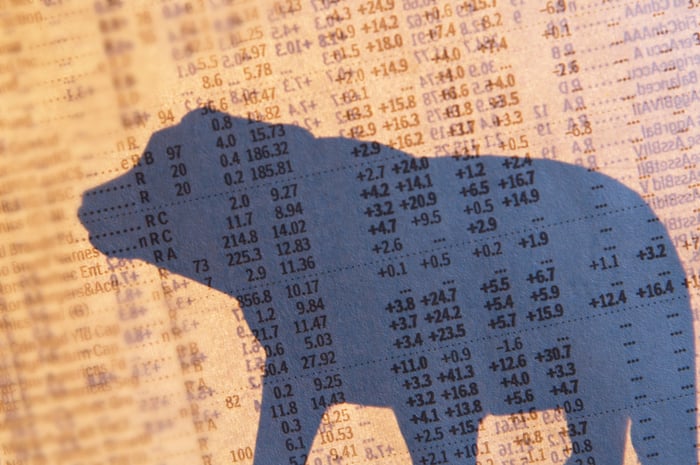Late last week marked the official kickoff to earnings season. While corporate earnings often take center stage on Wall Street, it's Federal Reserve commentary that's stolen the show.
Most investors have keyed in on interest rate commentary from the Federal Open Market Committee (FOMC), which is the 12-member body that makes decisions about our nation's monetary policy. However, last week's release of the March meeting minutes from the FOMC contained a forecast that some on Wall Street had hoped not to see. Taken directly from the meeting minutes:
Given their [the FOMC staff] assessment of the potential economic effects of the recent banking-sector developments, the staff's projection at the time of the March meeting included a mild recession starting later this year, with a recovery over the subsequent two years.
In other words, the Fed is now modeling a recession into their outlook.

Image source: Getty Images.
What would a U.S. recession mean for the ageless Dow Jones Industrial Average (^DJI -0.98%), growth-focused Nasdaq Composite (^IXIC -0.64%), and benchmark S&P 500 (^GSPC -0.46%)? Let's take a closer look at what history can tell us.
Recessions haven't been a walk in the park for Wall Street
Before we dive in, take note that no indicator, metric, or data point is ever foolproof. If there were an indicator that accurately called the start and end to bear markets, as well as how much stocks would decline during a bear market, everyone would be using it.
Nevertheless, history can serve as a fairly accurate guide of what to expect from stocks during a recession. What the dataset below shows, which was aggregated by Bank of America Global Research and shared on social media platform Twitter by David Marlin, the CEO of Marlin Capital, is that recessions have been anything but a walk in the park for Wall Street.
History suggests that the worst of the market declines happen during the Recession.
-- David Marlin (@Marlin_Capital) April 7, 2023
Since 1929, around 2/3rds of the $SPX peak to trough drawdowns have occurred during, not before, US Recessions. $SPY $QQQ $DJIA $AAPL pic.twitter.com/5l5WXduhwq
Looking back 95 years (since 1927), there have been 15 separate stock market drawdowns associated with U.S. recessions. Bank of America (BofA) Global Research examined the S&P 500's maximum drawdown during each declared recession, as well as the maximum drawdown during recessions from one year prior to a recession being declared.
The result of 95 years of data is crystal clear: Approximately two-thirds of all downside in the S&P 500 occur during a recession and not prior to one being declared by the eight-economist panel of the National Bureau of Economic Research (NBER). If we assume that the FOMC is correct in predicting a mild recession for later this year, the implication of this data would be that the Dow, Nasdaq, and S&P 500 haven't yet seen their lows.
To add to this point, independent investment research company Ned Davis Research found that no bear market has bottomed after World War II prior to a recession being declared by the NBER. On average, the stock market bottoms just shy of six months after a U.S. recession officially begins.

Image source: Getty Images.
Wall Street history is largely dependent on your investment time frame
On one hand, history doesn't bode well for Wall Street in the short term. While nothing is guaranteed for the Dow Jones, Nasdaq Composite, and S&P 500, BofA's dataset serves as a reminder that equities tend to struggle when economic uncertainty crops up.
But there are two sides to this coin. Determining what role history can play in influencing stocks largely depends on individual investing time frames.
For example, while recessions are an inevitable part of the economic cycle, they don't last very long. Every single recession after World War II has lasted between two months (the 2020 COVID-19 recession) and 18 months (the Great Recession). Recessions tend to be blips when examined with a wider lens, whereas periods of economic expansion are almost always measured in years.
Something else to consider is that every single double-digit decline in the Dow Jones Industrial Average, Nasdaq Composite, and S&P 500 throughout history has eventually given way to a bull market. Even though there's no way to accurately time when corrections, bear markets, or crashes will occur or bottom, buying during these downturns has traditionally been a smart move for investors with a long-term mindset.
^SPX data by YCharts. Gray notes denote U.S. recessions.
Thinking long term also allows investors to take advantage of Wall Street's closest thing to a guarantee. Every year, market analytics company Crestmont Research updates its calculations on what an investor would have made if they, hypothetically, purchased an S&P 500 tracking index at any point since the beginning of the 20th century and held that position for 20 years.
Out of the 104 ending years examined (1919 through 2022), all 104 rolling 20-year periods would have generated a positive total return, including dividends paid. No matter what Wall Street threw at investors, patience and optimism prevailed 100% of the time.
Furthermore, most of the 104 rolling 20-year periods produced big gains. Whereas just a handful of these rolling 20-year periods generated annualized total gains of 5% or less, around 40% of the ending years produced an annualized total return ranging from 10.8% to 17.1%.
While recessions are known for walloping equities over the short run, they've also marked phenomenal buying opportunities for patient investors.





